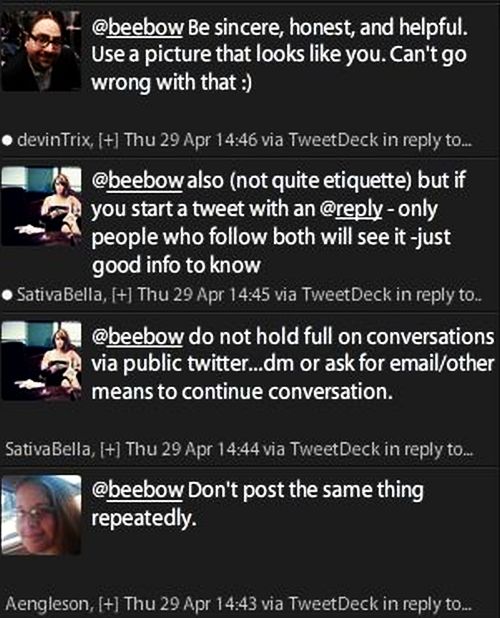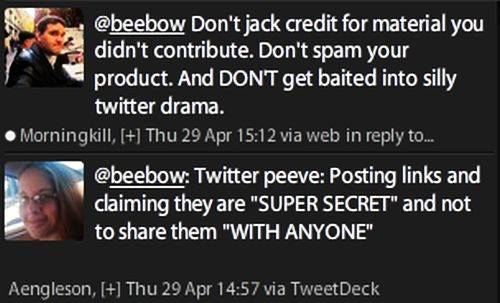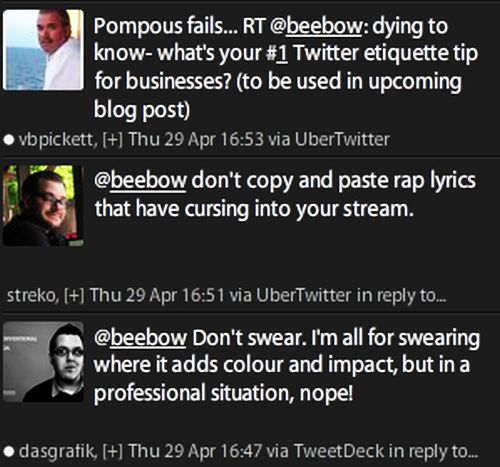
Whether you’re talking about sex, singing, or social media, it’s a fact of life: people don’t like to hear they’re “doing it wrong.” But when it comes to tweeting– a communal activity that’s constantly expanding in both significance and scope– how can you define what’s right? Everyone and their mother has an opinion about what it means to “use Twitter correctly,” particularly for businesses. Since Twitter is so versatile, the types of brands who use it so diversified, the debate about right versus wrong becomes more of a quest just to not be an oblivious jackass.
Seems simple enough, but we’ve watched businesses crash and burn thanks to a lack of Twitter tact. Social-savvy bloggers like Chris Brogan and Lisa Barone have taken the time to lay road maps of vernacular adoption and adaptation, so there’s no need to reinvent the wheel. Read on for a summary of popular opinion surrounding appropriate tone and timbre for how to handle your brand when out in about in the Twitterverse. Were Emily Post alive today, she’d no doubt tweet these takeaways regularly… ever so careful, of course, not to spam the snot out of us. (I know. Eloquent, right? 🙂 )
- The Self-Appointed Twitter Scolds teaches us that good etiquette is not pointing out petty mistakes. Even if you represent an esteemed publication company, it’s not your job to correct the grammar and spelling of other people’s tweets (especially if those people are following you, a.k.a. fans of your brand). You’re not @GrammarCop, and no one wants you to be. That dude doesn’t have too many alliances.
- Event Hashtag Etiquette: Overheard @ #SMXWest teaches us that good etiquette is being respectful of event coverage. Technically, a hashtag is anything preceded by a pound sign (#), even if you make it up on the spot. #NoReallyImBeingSeriousHereYouGuys. Trending hashtags, particularly ones associated with an event, are often monitored by the masses to absorb live coverage real-time. Help keep these hashtags clean by only using them in relevant and necessary cases.
A Brief And Informal Twitter Etiquette Guideteaches us that good etiquette is giving props to people other than yourself. Marketing your company is clearly an important part of social media marketing, but that doesn’t mean you have to talk about yourself 24/7. Interacting with other brands and industry top dogs shows you’re aware of and active in your community.9 Essentials of Twitter Etiquetteteaches us that good etiquette is knowing when to call it a day. A common misconception of Twitter, or any social media channel for that matter, is that they’re mandatory (and require freakish amounts of time). Look at Skittles. The dude/dudette in charge of their Facebook presence posts one unforgivably hilarious status update per day, and the crowd goes wild. To be effective on Twitter, your company doesn’t have to tweet for the sake of tweeting. Wait until you have something valuable to share. Then, share it.
Twitter Etiquetteteaches us that good etiquette is giving everyone equal access. Unlike Facebook, which now encourages you to identify your siblings and parents by name, your Twitter “profile” consists of your name, website, city/state and bio. That’s no more info than you’d share on your business card, so there’s no reason for you to put the padlock on your account and keep your updates “protected.”A Guide To Proper Twitter Etiquetteteaches us that good etiquette is responding to people who engage your brand. Alright, look– there is no excuse for not reaching out to those who discuss your brand via Twitter with their friends or engage your brand directly. Don’t forget about retweets- some say that’s the sincerest form of flattery nowadays. In the very least, it’s a form of engagement- so take time to tweet a simple “thank you” to the RTer.- 4 Tips For Tapping Into Twitter Conversations teaches us that good etiquette is being present when you’re mentioned. Conversations about your brand and industry are going to happen. Be aware, be prepared, and be active. Of course, since Twitter by its very nature emphasizes the rapid pace of real-time, a quick response is always a plus.
- How To: Not Suck At Writing Tweets teaches us that good etiquette is taking the time to spell check. Your tweets don’t have to be in accordance with AP Stylebook guidelines, but glaring typos can suggest you plum don’t care. Look over your message before you send it out to the masses. #Justsayin.
- Twitter Won’t Make You Suck Less. Ask Comcast teaches us that good etiquette is activity, not assumption. Jumping on the social media band wagon seems like yesterday’s cliché, but companies are still joining Twitter and Facebook under the pretense that it’s a quick-fix to customer service. Not so. Twitter, like any marketing strategy, requires participatory effort and attention.
Twitter manners- how to write good tweets and be a good twittizenteaches us that good etiquette is being honest. One obstacle brands face on Twitter is that of transparency. Do you tweet as a company? Do you have one person handle the voice? Have one person promote? And if so, do you ever really announce the link between voice and brand? Remember that the best way to gain trust is to be transparent. People won’t dislike you if you self-promote within reason, but lying about it a different story.
Bonus Advice From #SESNY
Automating Twitter: Can Humans & Robots Tweet In Harmony? teaches us that good etiquette is not relying on a bot to tweet for you. Automating the dirty work of Twitter such as leveraging tools to track tweet analytics or schedule occasional tweets is not only acceptable, it’s efficient. But don’t adopt a “set it and forget it” mindset when it comes to the whole “interacting with your followers” part.
Of course, tips on Twitter etiquette don’t have to come from professional social media strategists or community managers in order to be valuable. We polled the Twitterverse (a.k.a. your potential customers, fans and friends – so yeah, their opinions matter!) on the do’s and don’t’s of social couth. Here’s what they had to say:
If your company’s taking the initial plunge into the Twitter stream, we hope these posts and pointers serve as a useful guide to twetiquette. And if your brand’s committed a few (or, gasp, all) of these micro-blogging blunders, it’s high-time to get your head out of your ass, your elbows off the table, and your heart in the right place 🙂 .
















